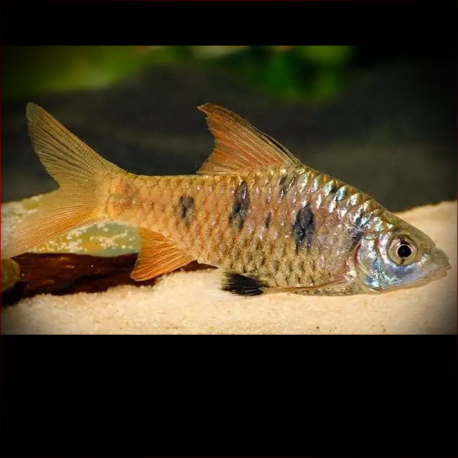More info
Datasheet
| Minimum Tank Size | 72 litres / 19.02 US gallons |
| Maximum Size | 6.5cm / 2.56inches |
| Temperature | 18°C / 64.40°F - 24°C / 75.20°F |
| Hardness | 2.02dgH / 36ppm - 15.02dgH / 268ppm |
| pH | 6.0-7.8 |
General Description
The Maharaja Barb, scientifically known as Puntius Sahyadriensis, is a peaceful fish ideal for community aquariums. It has a distinctive angular body shape, unique color pattern, and enlarged dorsal fin in males. Belonging to the Cyprinidae family, it is a small to mid-sized cyprinid found in the Western Ghats mountains in India.
Aquarium Setup
For optimal care, set up an aquarium resembling a flowing stream with varied-sized rocks, sand, gravel, and driftwood. Include plants like Microsorum, Bolbitis, or Anubias attached to the decor. Regular water changes of 30-50% tank volume and high oxygen levels are crucial for their well-being. Refer to the table for specific water conditions.
Behaviour
The Maharaja Barb is a peaceful species that thrives in mixed-sex groups. They interact intriguingly, displaying vibrant colors during male rivalries or courtship. Adding schooling fish enhances their security and natural behavior in the aquarium.
Feeding and Diet
Being omnivores, Maharaja Barbs feed on worms, insects, plant material, and algae. In captivity, they require a varied diet of live, frozen, and dried foods such as bloodworms, Daphnia, and quality flakes with plant content. Feeding them regularly maintains their health and vibrant colors.
Reproduction & Dimorphism
These barbs are egg-scattering breeders without parental care. To maximize breeding, condition the adults in a separate tank with dim lighting and spawning substrate. Males develop striking colors and tubercles during spawning, while females grow larger and less colorful.
Habitat and Distribution
Endemic to the Western Ghats mountains in India, Maharaja Barbs inhabit shaded stream habitats with boulders, sand, submerged tree roots, and leaf litter. They are often found alongside various fish species in the river drainages of the region.

